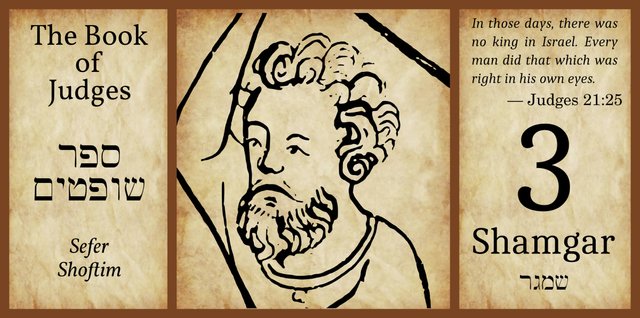
The third Judge of Israel, Shamgar, succeeded Ehud and was the first of the six Minor Judges:
And after [Ehud] was Shamgar the son of Anath, which slew of the Philistines six hundred men with an ox goad: and he also delivered Israel. (Judges 3:31)
Curiously, the very next chapter in the Book of Judges seems to imply that Ehud was succeeded by Deborah:
And the children of Israel again did evil in the sight of the Lord, when Ehud was dead. And the Lord sold them into the hand of Jabin king of Canaan, that reigned in Hazor; the captain of whose host was Sisera, which dwelt in Harosheth of the Gentiles. And the children of Israel cried unto the Lord: for he had nine hundred chariots of iron; and twenty years he mightily oppressed the children of Israel. And Deborah, a prophetess, the wife of Lapidoth, she judged Israel at that time. (Judges 4:1-4)
Shamgar does not seem to belong here:
31: Shamgar son of Anath: The report about Shamgar may be based on his mention in the Song of Deborah (5.6). It is reminiscent of other stories of heroism, such as the story about Samson who smote 1,000 people with the jaw bone of an ass (Judg. 15.15-16; cf. 2 Sam. 23.8). The inclusion of Shamgar among the judges rounds out their number to twelve. (Berlin & Brettler 517)
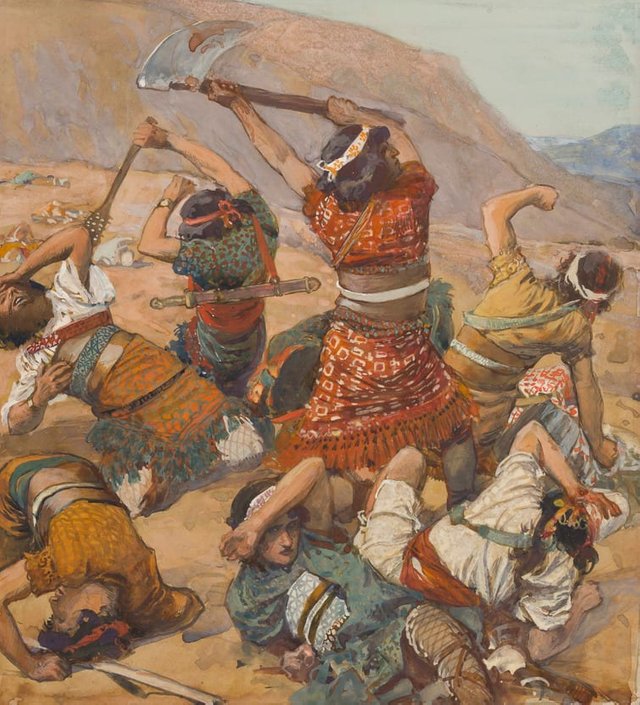
The Song Deborah mentions Shamgar briefly, without identifying him as a Judge of Israel:
In the days of Shamgar the son of Anath, in the days of Jael, the highways were unoccupied, and the travellers walked through byways. The inhabitants of the villages ceased, they ceased in Israel, until that I Deborah arose, that I arose a mother in Israel. (Judges 5:6-7)
It is easy to see how later rabbinical scholars might have deduced from this that Shamgar had been the Judge before Deborah, which led them to emend the text by inserting Judges 3:31. There are extant several ancient manuscripts, however, in which verse 3:31 is placed after the account of the Judgeship of Samson:
It has long been recognized that Jud. iii. 31, which tells how Shamgar killed six hundred Philistines with an ox-goad, was inserted by one of the latest editors of the book. It has not, however, been so generally observed that certain recensions of the old Greek version (codd. 44, 54, 56, 59, 75, 76, 82, 106, 134 H-P; sub obel. 121), together with the Hexaplar Syriac, Armenian, and Slavic versions, have the account of Shamgar’s exploit a second time after xvi. 31. Here, immediately following Samson, the Philistine-fighter is quite in order. Comparison of the renderings in the two places shows that the verse was not repeated at the end of c. xvi. by an editor of the Greek text, but was found there by the translators in their Hebrew manuscripts ... There is thus good reason to think that the verse at first stood after the story of Samson, and was subsequently, for some reason, removed to a place between Ehud and Barak.
That Shamgar cannot have been the original hero of this story is proved both by the earlier position of the verse (following Samson), and—more conclusively—by the fact that the Philistines did not appear upon the scene till long after the time of Deborah and Barak. (Moore 1898:159)
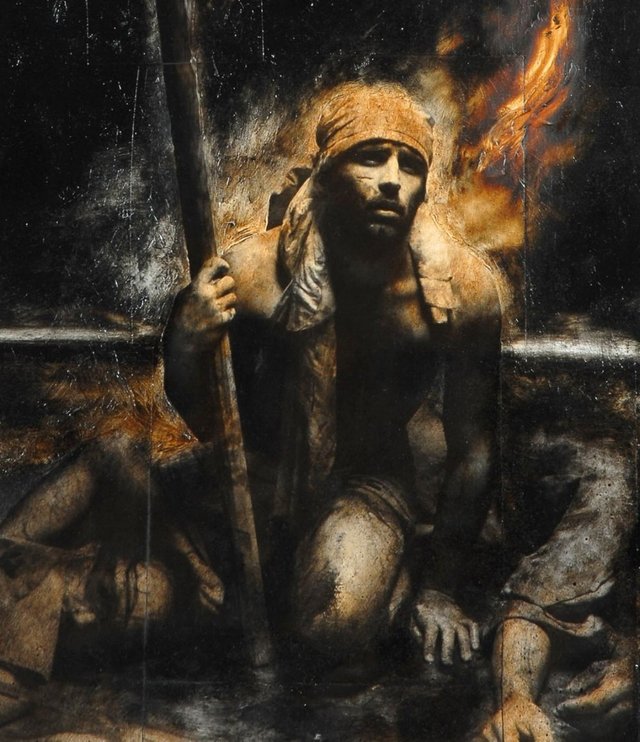
These anomalies, and the anachronistic appearance of the Philistines, have led commentators to dispute the historicity of Shamgar’s Judgeship:
III. 31. The Exploit of Shamgar.— The absence of [the Deuteronomist’s] formulae, and of a chronological scheme, suggests that this verse was introduced by an editor who wished to bring the number of the Judges up to ten, not counting Abimelech worthy to rank as one. The verse interrupts the flow of the narrative—observe “when Ehud was dead” in 4:2. Shamgar ben Anath is a foreign and heathenish name, Anath being a goddess whose name is found on an Egyptian stele now in the British Museum; and a reference to Shamgar in the Song of Deborah suggests that he had been an oppressor rather than a deliverer of Israel (cf. Moore, 143). The ox-goad, with which Shamgar performed his exploit, is a pole from 6 to 8 ft. [2-3 m] long, tipped with an iron spike. (Peake 261)
George Foot Moore, who is cited by Peake, was also suspicious of Shamgar’s identity, but he did not doubt his historicity:
The verse which tells his brief story exhibits, however, none of the distinctive formulas of the list 10:1-5, 12:8-15 and, what is more conclusive, Shamgar is not embraced with them in the final chronological scheme of the book; neither the period in which he wrought deliverance for Israel nor its duration is given. [Footnote: The Jewish explanation is that he died in the first year of his office. Fl. Jos.]
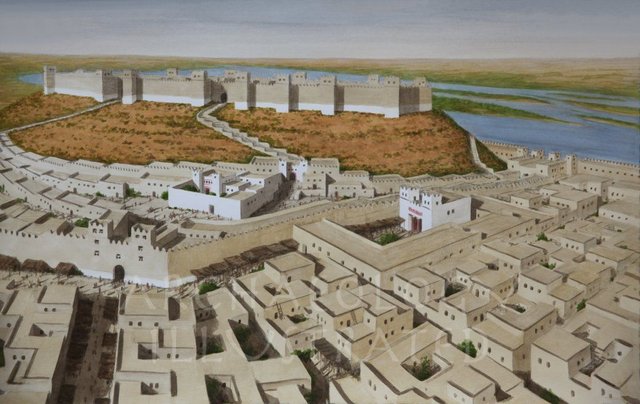
Chapter 4:1 (D) ignores Shamgar, connecting immediately with 3:30 (“when Ehud was dead”). It is to be inferred from these facts that the story of Shamgar’s exploit was inserted here by a hand not only later than the Deuteronomic author of 3:30 and 4:1, but than the editor who introduced the “Minor Judges” and made them a place in the chronology. (Moore 104-105)
Attempts have been made to tie Shamgar’s non-Hebrew name with various other names from the region, such as that of Sangara, King of Carchemish, in Syria. Shamgar’s name and exploits are also reminiscent of those of Shammah son of Agee, who is mentioned in the Second Book of Samuel.
Shamgar’s patronymic, Anath, has been compared to the name of the Semitic goddess Anath, believed by some to be a forerunner of the Greek Athena.
None of this does anything to strengthen the historicity of Shamgar. He is only mentioned in a footnote in Louis Ginzberg’s The Legends of the Jews (Ginzberg 6:194). According to the Legends, Ehud was succeeded by Deborah (Ginzberg 4:34-35).
Samson
Samson was the twelfth Judge of Israel. We will be examining his story in detail in a later article, but before leaving Shamgar, we must consider the possibility that he is simply a doublet of Samson. This question has been addressed online by independent researcher Paul Davidson

Furthermore, there is another, more well-known hero in Judges associated with the sun: Samson (Hebrew: Shimshon), whose name is a reference to Shemesh, the Canaanite sun god, and whose activities take place in the vicinity of Beit Shemesh, “House of the Sun”.
Solar symbolism is not all Shamgar has in common with Samson. Consider the following passage:
“When [Samson] came to Lehi, the Philistines came shouting to meet him; and the spirit of Yahweh rushed on him…. Then he found a fresh jawbone of a donkey, reached down and took it, and with it he killed a thousand men.” (Judges 15:14-15)
The obvious parallels between this passage and the Shamgar passage include the names of their respective heroes, the Philistines as a common enemy, the extraordinary number of men killed, and the use of a makeshift weapon—a farmer’s ox-goad for Shamgar, a donkey jawbone for Samson. It’s beginning to look like Shamgar and Samson are two versions of the same legendary hero. (Davidson)
Davidson goes on to compare Shammah’s story with the accounts of Shamgar and Samson, leading one to suspect that Shammah is yet another doublet of Samson. I leave the reader to study Davidson’s article at leisure. He delves much deeper into the story of Shamgar than I ever could.
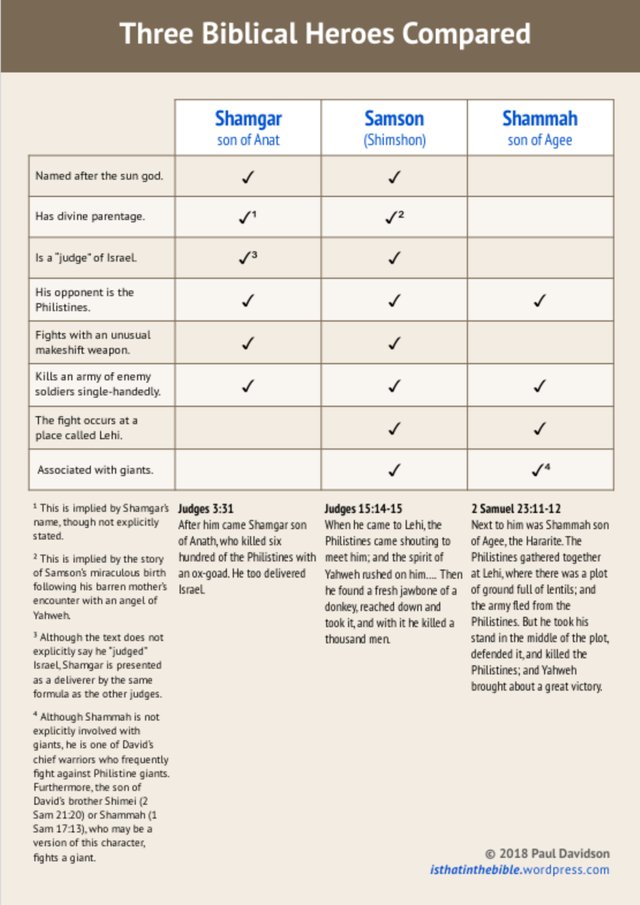
Conclusion
I believe it is safe to reject the historicity of Shamgar. His story is probably a doublet of the better known story of Samson.
And that’s a good place to stop.
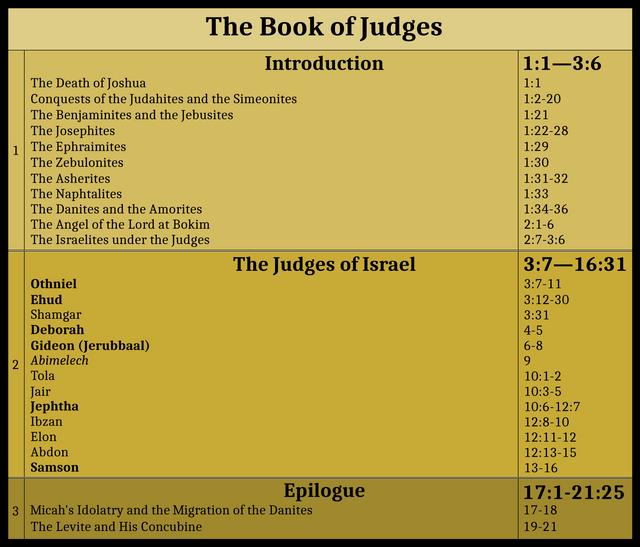
References
- Adele Berlin & Marc Zvi Brettler (editors), The Jewish Study Bible, Jewish Publication Society TANAKH Translation, Oxford University Press, Oxford (1999)
- Louis Ginzberg, The Legends of the Jews, Volume 4, Translated from the German by Henrietta Szold, The Jewish Publication Society of America, Philadelphia (1913)
- Louis Ginzberg, The Legends of the Jews, Volume 6, Translated from the German by Henrietta Szold, The Jewish Publication Society of America, Philadelphia (1928)
- George Foot Moore, A Critical and Exegetical Commentary on Judges, The International Critical Commentary Series, T & T Clark, Edinburgh (1895)
- George Foot Moore, Shamgar and Sisera, Journal of the American Oriental Society, Volume 19, Second Half, Pages 159-160, American Oriental Society, New Haven, CT (1898)
- Arthur Samuel Peake, A Commentary on the Bible, T C & E C Jack, Ltd, London (1920)
Image Credits
- Shamgar: Speculum Humanae Salvationis, Folio 31r (cropped), Universitäts- und Landesbibliothek Darmstadt, Darmstadt, Public Domain
- Shamgar, the Son of Anath: James Jacques Joseph Tissot (artist), Gift of the Heirs of Jacob Schiff, The Jewish Museum, New York, Public Domain
- Shamgar and the Ox Goad: © Kevin Rolly (artist), Fair Use
- An Artist’s Reconstruction of Carchemish: Balage Balogh (artist), Archaeology Illustrated, Fair Use
- Samson and the Philistines: Giulio Cesare Procaccini (artist), Museo del Prado, Madrid, Public Domain
- Three Biblical Heroes Compared (Davidson): © Paul Davidson, Fair Use
Online Resources
